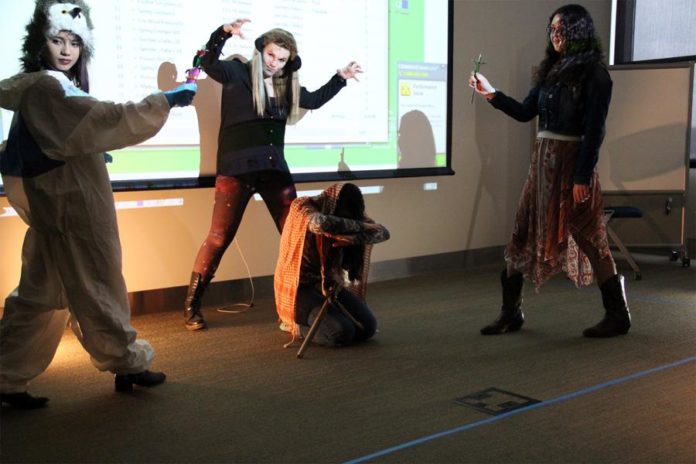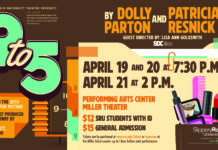The Global Images of U.S. Women showcase used art, a guest speaker and a workshop to convey discrepancies between the United States and other cultures’ views on women, and other social issues.
Global Images of U.S. Women was hosted by the gender studies program, the Martha Gault Art Society, and the Know Art Society. The first part of the showcase was an exhibition of international “postcard art,” which was done in multiple mediums on postcard-sized paper. The exhibit was hosted in the Smith Student Center Theater on Monday through Wednesday, and had over 200 submissions, including art featuring celebrities, clothing, and other things that international artists thought were inherently American.
Dr. Cindy Lacom said that one of the most telling things she saw from the art was the reoccurrence of shoes among the pieces.
“Shoes are a big tell-tale of not only social classes,” she said, “but also of cultures, like Chinese foot binding, and the fetishization of high heels in the U.S.”
Senior emerging technology major, Nicole Doran, 22, said that she thought the subtractive nature of some of the art told a story.
“It’s as though it represents how society chips away at women until it gets what it wants from them,” Doran said.
Lacom also said that how predominant portraits of figures such as Hilary Clinton and Oprah Winfrey showed how predominant mass media is not only within the U.S., but also within other countries’ perceptions of the U.S. Another predominant theme was portraits of women with a negative body image, and especially of women draped in flags. Lacom said that that could be taken to mean that American womens’ bodies are marked by capitalism.
“I think it’s interesting that we condemn things like female circumcision, but don’t open that conversation to things like breast augmentation,” she said. “It’s very telling of the kind of society we live in.”
The Gender Studies program also invited performance artist, Tavia Lafollette, to talk about crossing borders Tuesday not only with regard to gender, but also to talk about crossing borders between other cultures, which was called “Border X-ing,” and involved a supplementary workshop that showed art students how to create their own performance art.
Lafollette is the executive director of “Art Up,” which is a nonprofit gallery and performance space that teams with Pittburgh’s The Mattress Factory art museum, to showcase international art, which specifically focuses on political issues and anti-violence. She also said that prejudgement of people and stereotyping negatively affect people everyday.
“Even growing up in a liberal household, I still come equipped with prejudgement,” she said. “It’s how the human brain categorizes things, but even though some people can say they hate another group of people, you can’t hate them when you sit at a dinner table with them, sleep in the same household as them, and talk about things with them.”
Lafollette has participated in performance art in Egypt, and was there in the aftermath of the revolution. She said that it’s important for U.S. artists to recognize artists from other countries because their work takes on a different lens than American art does.
“When I was done with my work in Egypt, I got to leave,” Lafollette said. “If anything happened in Egypt, its citizens would have no where to go.”
The subsequent workshop, titled “Performance Box: Making Metaphors,” which focused on how to change the context of performance art by switching props and adjusting lighting. Lafollette asked students to volunteer to demonstrate how changing small parts of a piece can affect its interpretation.
Senior fine arts major, Emily Smith, 22, said that the workshop helped her understand how important it is to interact with other artists.
“During the workshop, we bounced ideas off of each other the whole time,” Smith said. “It was interesting to see what other students brought to the table.”
After the demonstration, Lafollette said that the point she was trying to make was that people can utilize art to advocate for social change.
“With performance art, you get to take the voice away from politicians with their watered-down rhetoric, and give that voice back to the people,” she said.








